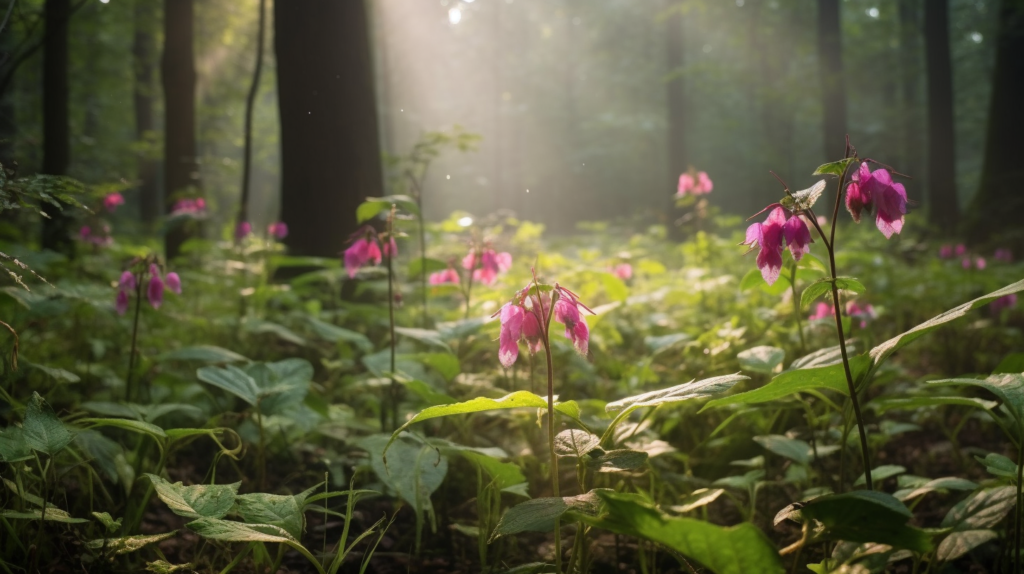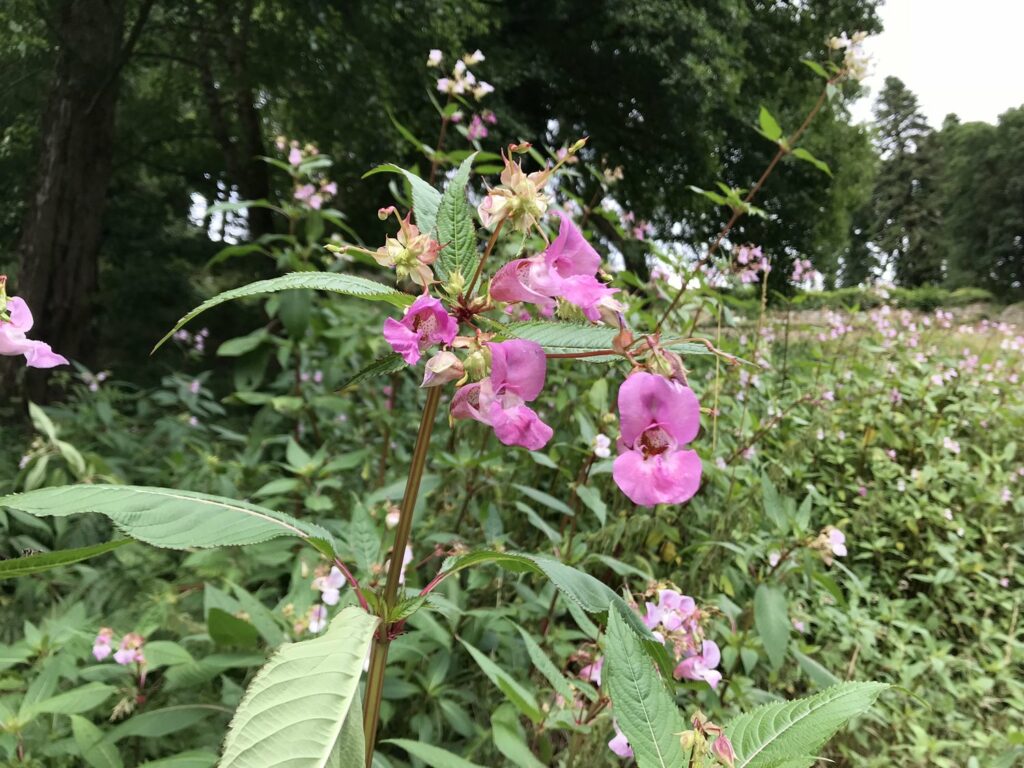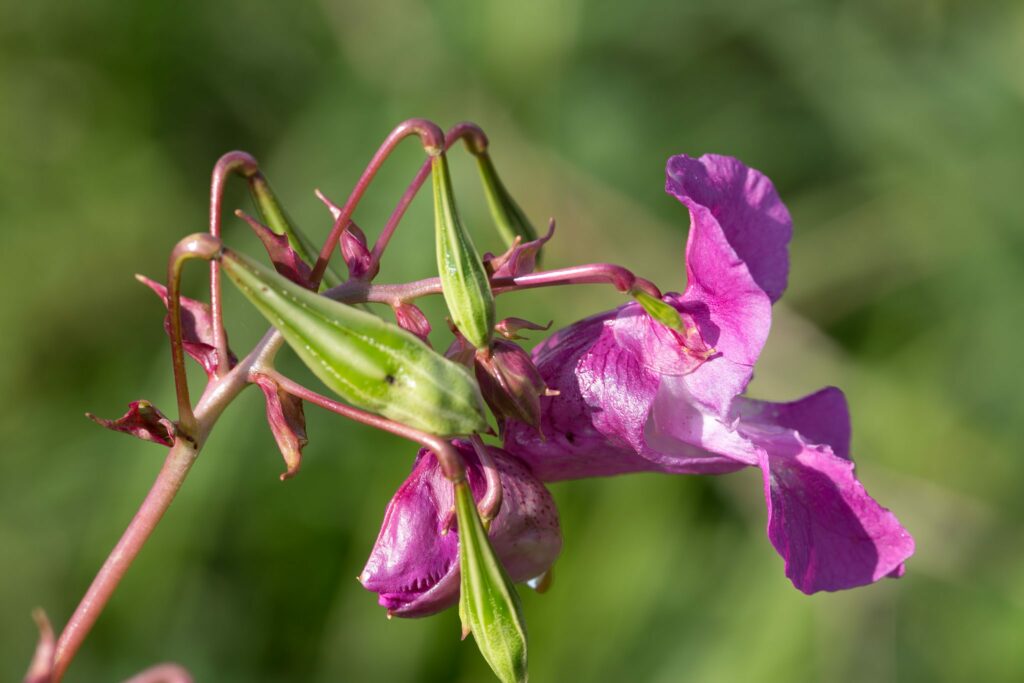Himalayan Balsam, also known as Indian balsam, jumping jack, policeman’s helmet, is a fascinating plant with beautiful flowers that have captivated gardeners and nature enthusiasts alike. Originating from the Himalayas, this annual plant has gained popularity as an ornamental plant in many parts of the world. However, its rapid growth and invasive tendencies have raised concerns among environmentalists and conservationists.
What is Himalayan Balsam?
Himalayan Balsam is a flowering plant that belongs to the Balsaminaceae family. It is characterised by its tall, hollow stems, green leaves, and striking pink or purple flowers. The plant produces seed pods that explode when touched, dispersing its seeds over long distances. This unique mechanism has earned it common names such as “Touch-Me-Not” and “Impatiens.”

The Growing Popularity of Himalayan Balsam
Due to its aesthetic appeal and ability to attract pollinators, Himalayan Balsam has become a desirable garden plant for many enthusiasts. Its distinctive presence and abundance of nectar make it an attractive addition to gardens and landscapes. However, the plant’s invasive nature poses a threat to native species and ecosystems.
Features of Himalayan Balsam
Himalayan Balsam is characterised by its rapid growth and dense vegetation. It can reach heights of up to three meters, overshadowing and out-competing native plants for sunlight and resources. The plant’s hollow stem allows it to float and disperse downstream, making river banks and river systems vulnerable to invasion.
Himalayan Balsam is also known for its large and lush green leaves. These leaves provide a dense canopy, further shading out native plants and reducing their chances of survival. The stems of Himalayan Balsam are notably hollow, which aids in its buoyancy and facilitates its spread through waterways.

Invasive Nature of Himalayan Balsam
Himalayan Balsam is classified as an invasive plant species in many regions. Its ability to out-compete native plants for resources hampers the growth and survival of desirable garden plants and native species. The plant’s rapid spread along river banks contributes to river bank erosion, disrupting the stability of river systems.
Invasive plants like Himalayan Balsam often possess specific characteristics that give them a competitive advantage over native species. The plant’s high growth rate allows it to establish dense stands, creating monocultures that reduce the biodiversity of an area. It out-competes native species for sunlight, nutrients, and water, leading to a decline in the abundance and diversity of native flora.
Impact on Native Species and River Systems
The invasive nature of Himalayan Balsam poses a threat to the biodiversity of ecosystems. It forms dense monocultures, reducing the habitat available for native species. Additionally, its dense growth along river banks displaces native vegetation, leading to increased soil erosion and reduced water quality.
River systems are particularly susceptible to the negative impacts of Himalayan Balsam. The plant’s ability to disperse its seeds through water allows it to colonise new areas rapidly. As it establishes along river banks, it out-competes native vegetation, compromising the stability of the soil. This, in turn, can contribute to increased river bank erosion and alter the natural flow of water.

Controlling the Spread of Himalayan Balsam
Efforts are being made to control the spread of Himalayan Balsam and mitigate its impact on native ecosystems. Various methods, both manual and chemical, are employed to manage its growth. However, it is essential to consider the potential impact on non-target species and the environment when implementing control measures.
Natural Enemies and Non-Chemical Control Methods
One approach to controlling Himalayan Balsam is by utilising its natural enemies, such as insects and diseases, which can help reduce its population. These natural enemies feed on the plant, causing damage and limiting its growth. Introducing these natural enemies to areas infested with Himalayan Balsam can be an effective and environmentally friendly control strategy.
Non-chemical control methods, such as manual removal and cutting, can also be effective in managing the growth of Himalayan Balsam. These methods aim to prevent the plant from producing seeds and spreading further. Regular monitoring and removal of seed pods can help prevent its establishment and growth. It is crucial to implement these control methods early in the growing season to achieve the best results.
Managing Himalayan Balsam in Gardens
For those who have Himalayan Balsam in their gardens, it is crucial to take preventive measures to avoid its spread. Regular monitoring and removal of seed pods can help prevent its establishment and growth. Planting native species and maintaining a diverse garden can also reduce the risk of invasive plants taking over.
Gardeners should consider the potential impact of planting Himalayan Balsam on the surrounding environment. The plant’s ability to produce a large amount of nectar can attract pollinators, but it may also out-compete native plants that provide essential food sources for local wildlife. Therefore, it is advisable to plant a variety of native species that support local ecosystems and provide habitats for wildlife.
Conclusion
Himalayan Balsam, with its stunning flowers and rapid growth, is an intriguing plant that has both admirers and critics. While it adds beauty to gardens, its invasive tendencies pose significant challenges to native species and river systems. By understanding its impact and implementing appropriate control measures, we can mitigate the spread of Himalayan Balsam and preserve the biodiversity of our natural environments.
Additional Resources
Sources and References
- Himalayan Balsam – invasivespecies.scot
- Himalayan Balsam (Impatiens glandulifera) – invasivespeciescentre.ca

Faye is a valuable contributor at Glenlivet Wildlife, with a degree in Botany and expertise in plants and flowers. She has embarked on expeditions to remote areas, interviewing renowned botanists and biologists to provide unique insights into flora worldwide. Her favourite flower is the Jade Vine, admired for its beautiful colour and delicate appearance.
